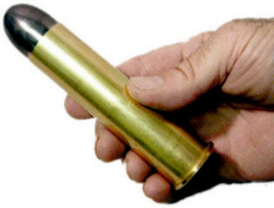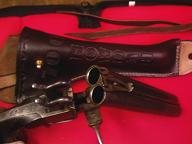

 The Accurate Reloading Forums
The Accurate Reloading Forums  THE ACCURATE RELOADING.COM FORUMS
THE ACCURATE RELOADING.COM FORUMS  Rifles
Rifles  Wildcats And Their Development
Wildcats And Their Development  Which load program?
Which load program?Go  | New  | Find  | Notify  | Tools  | Reply  |  |
one of us |
Hi all, I hear alot about quickload. Is this the allaround good one to get? Or is there another that works better? | ||
|
| one of us |
the nice thing about quickload is it allows "what if" easily. The programs has fairly complex burning curve characteristics for each powder and allows the user to modify and tune them for his particular application. If you are in engineering and used to simluators, this is the program. regards, steve | |||
|
| one of us |
If you like programs that are easier to use, the version 3 of AccuLoad is due to be released in a couple of months. The load calculating program within it (CalcuLoader) is being replaced with LoadTech, a much stronger program. It can calculate loads for high pressure rifle cartridges, low pressure, low capacity cartridges, straight wall cases, handgun cartridges, big bore, you name it. That module will also be available as a stand-alone product in about one month or less. Regards, HockeyPuck | |||
|
one of us |
I'm taking this on this subject because I couldn't post a new topic for some reason. Hi all, I finished my first attempt at a home made chamber reamer today. I'm looking for something like a 3200 Hawk or 8mmGibbs. I started with O-1 and turned it to size, then put in the mill and cut 2 90deg flutes in it. I heated to a chery red and quenched in motor oil. I then ground reliefs and sharpened. I then noticed that the pilot was not true with the rest of the reamer. It looks like it warped about 1/8" off of center. I thought I put it fairly straight and fast into the oil, but maybe I could have been slightly off of straight up and down. Any thoughts on how to prevent this in the future? I ground the pilot down and tried the reamer on a short piece of barrel left from the muzzle when I did my sporterized Turk 8mm. It cut really good for about 1.5" then started acting up. Maybe I should have drilled out most of it, then used to finish it up. Was it not hard enough? If I quenched in water would it be too brittle? I picked up a 60deg cutter and might try a 6 flute next. How do I keep it from warping while quenching? Any thoughts? | |||
|
| one of us |
Hi Lar- Sounds like you have run into the classic hardening problem: finish to size and hope the quench doesn't mess up the dimensions too badly, or semi finish, then quench and put up with tough machining for the finishing of the piece. I would assume that most commercial reamers are hardened and then ground to final dimensions, as this is the only way to efficiently work with hardened tool steel and maintain correct dimensions in the final part. I have used O1 steel in making knives. It's good stuff. I'd stay with the oil quench. Water or brine quenches will be much more violent and may have undesirable results (like brittleness and material stresses). An oil quench in this steel will give you all the hardness you need in a bbl reamer. Properly hardened knife blades can whittle common nails without damage! Make sure that the hot part enters the oil bath quickly and evenly, and then make sure to agitate it within the bath to avoid any hot pockets of oil that will mess up a constant/even heat transfer from the surface of the part. Hot zones will prevent even cooling and can cause warpage. The warped part could be due to residual stresses in the steel from the machining operations, or from the rolling mill in the first place. You can anneal the part, adjust the shape, and then quench again to restore hardness. It won't hurt the steel to go thru the process a few times. You're just readjusting the crystal structure within it. I'm not sure how hard it will be to maintain straightness of all those different diameters of material during a heat treat. The different amounts of material in each area will be a definite factor. The smaller diameters have a greater tendency to warp during the quench, especially at the junction between small pilot diameter and the larger case diameter. Have you thought about making it in two pieces? You could make the reamer body as one piece with a drilled/tapped hole in the throat area. Then make a mating piece for the pilot. Add a good shoulder as a mating surface to maintain squareness, and you might get away with it for the small number of chambers you will be cutting. Might not be the most durable design, but it could get you around the need for a cylinder grinding machine and let you maintain the trueness of each portion during the quench... HTH maxman | |||
|
one of us |
Maxman, sounds like a great idea. A reamer for the body with removable pilot, then a seperate one for the neck and throat. It could be more useable with just makeing different neck and throat reamers. With your explanation it would seem that the 2 flute would be more stable than a 6 flute. ???? thanks. | |||
|
| one of us |
I think that 6 smaller flutes would be easier on the tool than 2 larger flutes. As long as the overall cut depth is constant, more flutes distribute the cutting pressure better - less chipload per tooth. Easier on the tool when cutting, plus you'll end up with a better surface finish in the chamber, which means less polishing after chambering. The fewer abrupt changes in part geometry (like corners of flutes and changes in diameter without a stress easing radius) the better it will come thru the hardening process. Smooth and flowing is good, sharp corners are bad, as a general rule. Of course, in your case, you will have to have some sort of corners - it is the nature of the fluting! Also bear in mind that the tips of the flutes (the cutting edges) will end up being harder than the body of the cutter. They will cool faster and more completely than the interior of the reamer. In your case, this is good. The cutting edges will be hard and the interior of the part will be softer (tougher). A good combination of properties I think. This is also why you can't drop heat treated cutters like reamers - they can chip or crack a flute if they are too brittle. Let us know how the adventure goes. maxman | |||
|
one of us |
Ordered Calculoader, think I'll give it a try. It seems the consensus that I've gotten from People who have made reamers is to start oversize, then grind to final size after quenching. I may have to make a jig to go on my wet/dry grinder. | |||
|
| Powered by Social Strata |
| Please Wait. Your request is being processed... |
|

Visit our on-line store for AR Memorabilia

